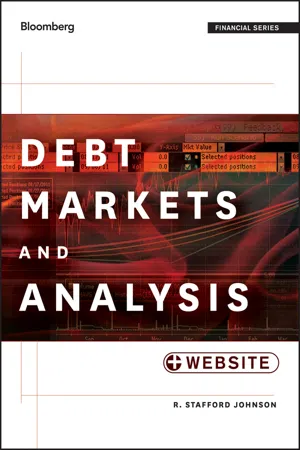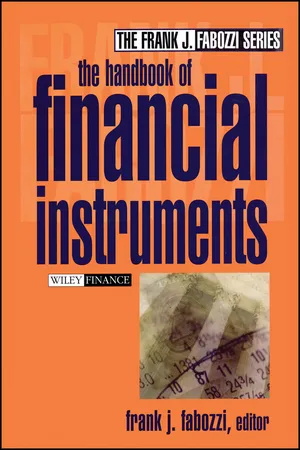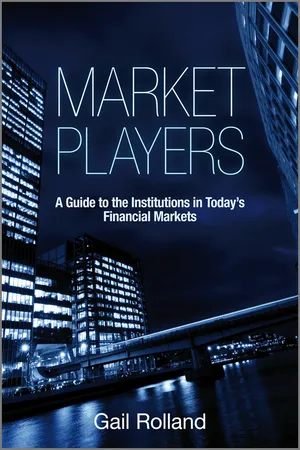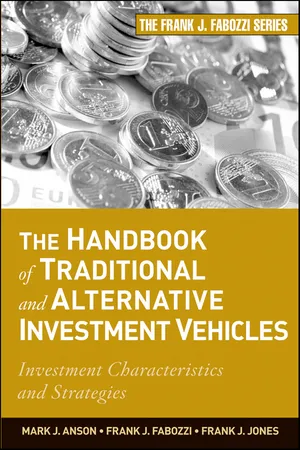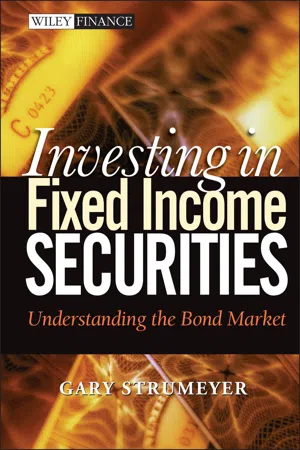Economics
Agency Bonds
Agency bonds are debt securities issued by government-sponsored enterprises (GSEs) such as Fannie Mae, Freddie Mac, and the Federal Home Loan Banks. These bonds are not directly backed by the government but are considered to have low credit risk due to the implicit guarantee of the issuing agency. They are often used to finance activities related to housing, agriculture, and other public services.
Written by Perlego with AI-assistance
Related key terms
1 of 5
11 Key excerpts on "Agency Bonds"
- eBook - PDF
Investments
Analysis and Management
- Gerald R. Jensen, Charles P. Jones(Authors)
- 2020(Publication Date)
- Wiley(Publisher)
Government Agency Securities Starting in the 1920s, the federal government created various federal agencies designed to help certain sectors of the economy, through either direct loans or guarantee of private loans. These credit agencies compete for funds in the marketplace by selling government agency securities . Two types of government agencies have existed in the U.S. financial system: fed-eral agencies and Government-Sponsored Enterprises (GSEs). 1. Federal agencies are part of the federal government, and their securities are fully guaranteed by the Treasury. The most important “agency” for investors is the Government National Mortgage Association (often referred to as “Ginnie Mae”). Ginnie Mae securities are the only mortgage-backed securities that are backed by the “full faith and credit” of the U.S. government. 2. GSEs are publicly held, for-profit corporations created by Congress. GSEs sell their own securities in the marketplace in order to raise funds for their spe-cific purposes. Although these agencies have access to credit lines from the government, their securities are not explicitly guaranteed by the government as to principal or interest. GSEs include the Federal Home Loan Bank and the Farm Credit System. 18 The Federal National Mortgage Association (“Fannie Mae”) and the Federal Home Loan Mortgage Corporation (“Freddie Mac”) started as federal agencies and later offered stock to the public, becoming GSEs. 19 They buy mortgages from finan-cial institutions, freeing them to make more mortgage loans to Americans. Because of their Congressional charters, the financial markets believed that the government would not allow these GSEs to default. In September 2008, a Federal takeover of Fannie Mae and Freddie Mac occurred. - eBook - ePub
The Capital Markets
Evolution of the Financial Ecosystem
- Gary Strumeyer(Author)
- 2017(Publication Date)
- Wiley(Publisher)
CHAPTER 11 Government‐Sponsored Enterprises and Federal Agencies David Isaac and Francis C. Reed, Jr. INTRODUCTION Government‐sponsored enterprises (GSEs) are chartered by Congress, and in some cases given lines of credit from the Department of Treasury to provide a continuous, low‐cost source of capital to specific types of borrowers, most notably, homeowners, farmers, and students. Some GSEs are publicly owned and traded in the equity market while others are corporations wholly owned by the U.S. government. GSEs are a uniquely American concept—a symbol of American idealism, resourcefulness, and optimism combined with free‐market capitalism. Commonly referred to as U.S. agencies, the debt securities issued by the GSEs are publicly traded across the globe. The security for agency debt falls into two general categories: (1) explicitly guaranteed by the full faith and credit of the U.S. government, and (2) supported by, but not guaranteed by, the U.S. government. (See Table 11.1.) Two of these agencies, the Federal National Mortgage Association (FNMA or Fannie Mae) and the Federal Home Loan Mortgage Corp. (FHLMC or Freddie Mac), were instrumental in the creation of one of the largest and most liquid markets in the world, the mortgage‐backed securities or MBS market. Collectively, the success of the GSEs has contributed greatly to the unprecedented expansion of the U.S - eBook - PDF
Investments
Analysis and Management
- Gerald R. Jensen, Charles P. Jones(Authors)
- 2019(Publication Date)
- Wiley(Publisher)
Government Agency Securities Starting in the 1920s, the federal government created various federal agencies designed to help certain sectors of the economy, through either direct loans or guarantee of private loans. These credit agencies compete for funds in the marketplace by selling government agency securities. Two types of government agencies have existed in the U.S. financial system: fed- eral agencies and Government-Sponsored Enterprises (GSEs). 1. Federal agencies are part of the federal government, and their securities are fully guaranteed by the Treasury. The most important “agency” for investors is the Government National Mortgage Association (often referred to as “Ginnie Mae”). Ginnie Mae securities are the only mortgage-backed securities that are backed by the “full faith and credit” of the U.S. government. 2. GSEs are publicly held, for-profit corporations created by Congress. GSEs sell their own securities in the marketplace in order to raise funds for their spe- cific purposes. Although these agencies have access to credit lines from the government, their securities are not explicitly guaranteed by the government as to principal or interest. GSEs include the Federal Home Loan Bank and the Farm Credit System. 18 The Federal National Mortgage Association (“Fannie Mae”) and the Federal Home Loan Mortgage Corporation (“Freddie Mac”) started as federal agencies and later offered stock to the public, becoming GSEs. 19 They buy mortgages from finan- cial institutions, freeing them to make more mortgage loans to Americans. Because of their Congressional charters, the financial markets believed that the government would not allow these GSEs to default. In September 2008, a Federal takeover of Fannie Mae and Freddie Mac occurred. - eBook - PDF
- R. Stafford Johnson(Author)
- 2013(Publication Date)
- Bloomberg Press(Publisher)
The federally chartered bank lending institutions include the federal home loan banks and the federal farm credit banks. GSEs sell securities and use the proceeds to provide loans and liquidity to support the housing industry, banking system, agriculture sec- tor, and college loan programs. Non-GSE federal agencies are true federal agencies created by the U.S. govern- ment. Included in this group are the Export-Import Bank, the Private Export Fund- ing Corporation, Tennessee Valley Authority (TVA), Federal Housing Administration (FHA), and Small Business Administration (SBA). Some of the non-GSEs, like the TVA, issue their own securities. Those agencies that do not issue their own debt use the Federal Financing Bank to raise their funds. Finally, there are some outstanding issues of one-time GSE issuers. These include the Resolution Trust Corporation, the Farm Credit Assistance Program, and the Financing Corporation. Collectively, the debt claims sold by GSEs and federal agencies are referred to as agency securities. For investors, these claims have been considered virtually default free because of the agency’s or company’s affiliation with the federal government (some federal agency issues are backed by Treasury bonds and many agencies have lines of 336 Debt Markets and Securities credit with the Treasury). Following the bailout of savings and loans institutions and banks in the 1980s and early 1990, the General Accounting Office and the Treasury began requiring that all federally sponsored agencies maintain a triple-A credit rating or lose their government support. Following the 2008 financial crisis, the securities of Fannie Mae and Freddie Mac received backing by the U.S. Treasury as part of the Treasury’s bailout program. The yields on agency securities are highly correlated with the yields on Treasuries, with the yield spread of federal over Treasury being positive. - eBook - ePub
- Frank J. Fabozzi(Author)
- 2018(Publication Date)
- Wiley(Publisher)
Chapter 9 Federal Agency SecuritiesFrank J. Fabozzi, Ph.D., CFAAdjunct Professor of Finance School of Management Yale UniversityGeorge P. KeglerPresident Cassian Market ConsultantsFederal agency securities can be classified by the type of issuer-federally related institutions and government-sponsored enterprises. Federal agencies that provide credit for certain sectors of the credit market issue two types of securities: debentures and mortgage-backed/asset-backed securities. Our focus here is on the former securities.FEDERALLY RELATED INSTITUTIONS
Federally related institutions are arms of the federal government and generally do not issue securities directly in the marketplace. Federally related institutions include the Export-Import Bank of the United States, the Tennessee Valley Authority, the Commodity Credit Corporation, the Farmers Housing Administration, the General Services Administration, the Government National Mortgage Association, the Maritime Administration, the Private Export Funding Corporation, the Rural Electrification Administration, the Rural Telephone Bank, the Small Business Administration, and the Washington Metropolitan Area Transit Authority.All federally related institutions are exempt from SEC registration. With the exception of securities of the Tennessee Valley Authority and the Private Export Funding Corporation, the securities are backed by the full faith and credit of the U.S. government. Interest income on securities issued by federally related institutions is exempt from state and local income taxes. - eBook - ePub
Market Players
A Guide to the Institutions in Today's Financial Markets
- Gail Rolland(Author)
- 2011(Publication Date)
- Wiley(Publisher)
These products can also become even more complex as they incorporate not just pure loans but also derivative contracts, making ever more complex products. In theory, though, asset-backed securities should offer a double level of protection and we have seen instances in the markets when borrowers with this sort of asset-backed debt have gone into bankruptcy and the structure has worked perfectly returning 100% of lenders’ funds in a very short space of time. The keys must lie in the assets but also in the house that originates the securities. So as long as the assets are secure, stable in value and can be easily sold in the market then there should be no problems in the market – it is just a shame that this may be asking too much of many of the asset pools. US MORTGAGE AGENCIES Probably the most famous agencies in the financial markets are the US agencies, particularly Federal National Mortgage Association (FNMA – often referred to as Fannie Mae) and Government National Mortgage Association (GNMA – Ginnie Mae). Both of these agencies are involved in mortgage financing but are very different from one another in the scope of their business and their presence in the markets. To look first at Ginnie Mae, this agency is a perfect example of a government agency as its aim is to enable mortgages for affordable housing. It was established in 1968, and carries with it a full US government guarantee making it one of the safest borrowers in the market. It is also famous for being an innovator of the mortgage-backed security market, asset-backed securities in which as we said the asset pool is a collection of mortgages. These individual mortgages have to meet certain criteria such as being insured by approved insurers to increase the security of the deals. Any banks and mortgage companies from which Ginnie Mae accepts loans for their backing also have to be approved - eBook - PDF
The Future of Housing Finance
Restructuring the U.S. Residential Mortgage Market
- Martin Neil Baily(Author)
- 2011(Publication Date)
- Brookings Institution Press(Publisher)
For example, the agencies had $2.25 billion lines of credit with the U.S. Treasury, and they were exempt from state and local taxes. Their obligations were classified 2. The charters are not specific about exactly what types of private-label securities can be held but do offer some general restrictions on quality. For example, Fannie Mae’s charter states, “The operations of the corporation under this section shall be confined, so far as practicable, to mort-gages which are deemed by the corporation to be of such quality, type, and class as to meet, gener-ally, the purchase standards imposed by private institutional mortgage investors.” Figure 4-6. Mortgage-Backed Securities Outstanding, 1971–2007 Source: FHFA. Millions of dollars 1971 1975 1979 1983 1987 1991 1995 1999 2003 2007 Fannie Mae Freddie Mac Total 4.0 3.5 3.0 2.5 2.0 1.5 1.0 0.5 The Government’s Role in the Housing Finance System 75 as “government securities,” which, among other things, meant that they were eligible for unlimited investment by financial institutions insured by the Federal Deposit Insurance Corporation (FDIC) and that they were exempt from the registration and reporting requirements of the Securities and Exchange Com-mission. In addition, until the summer of 2008, there was no resolution process for addressing an insolvent GSE. The GSEs’ ability to borrow cheaply fostered growth in their portfolios. As shown in figure 4-7, the combined portfolios of the GSEs rose from $0.1 trillion (equivalent to 2 percent of GDP) in 1990 to $1 trillion (equivalent to 10 per-cent of GDP) in 2000. They continued to grow over the first half of the last decade, topping out at $1.6 billion (equivalent to 13 percent of GDP) in 2004, before receding a bit in more recent years. This growth, in turn, reinforced the perceived implicit guarantee, as the agencies became increasingly viewed as too big to fail without creating systemic risk to the financial system. - eBook - ePub
The Handbook of Traditional and Alternative Investment Vehicles
Investment Characteristics and Strategies
- Mark J. P. Anson, Frank J. Fabozzi, Frank J. Jones(Authors)
- 2010(Publication Date)
- Wiley(Publisher)
There are five GSEs that currently issue debentures: Freddie Mac, Fannie Mae, Federal Home Loan Bank System, Federal Farm Credit System, and the Federal Agricultural Mortgage Corporation. Fannie Mae, Freddie Mac, and Federal Home Loan Bank are responsible for providing credit to the housing sectors. The Federal Agricultural Mortgage Corporation provides the same function for agricultural mortgage loans. The Federal Farm Credit Bank System is responsible for the credit market in the agricultural sector of the economy.In addition to the debt obligations issued by these five GSEs, there are issues outstanding by one-time GSE issuers that have been dismantled. These GSEs include the Financing Corporation, Resolution Trust Corporation, and the Farm Credit Assistance Corporation. One former GSE, Student Loan Marketing Association (Sallie Mae), elected to alter its status.Description of GSEs and Securities Issued
The five GSEs that currently issue securities are discussed next. In general, GSEs issue two types of debt: debentures and discount notes. Debentures can be either notes or bonds. GSE-issued notes, with minor exceptions, have 1- to 20-year maturities and bonds have maturities longer than 20 years. There are issues with bullet maturities and those with call provisions. GSEs also issue structured notes that we will describe in Chapter 7. Discount notes are short-term obligations with maturities ranging from overnight to 360 days. As with Treasury bills, no coupon interest is paid. Instead, the investor earns interest by buying the note at a discount.GSEs have programmatic platforms for issuing securities to introduce greater transparency in their funding programs and to promote greater liquidity for the securities that they issue debt. These programmatic platforms involve preannounced funding calendars and large minimum sized issues. Fannie Mae issues Benchmark Bills, Notes, and Bonds in this way and Freddie Mac issues Reference Bills, Notes and Bonds. The Federal Home Loan Banks and the Federal Farm Credit Banks, through their respective funding entities—the Federal Home Loan Banks Office of Finance and the Federal Farm Credit Funding Corporation—have a programmatic debt platform. - eBook - ePub
Investing in Fixed Income Securities
Understanding the Bond Market
- Gary Strumeyer(Author)
- 2012(Publication Date)
- Wiley(Publisher)
Bonds issued by GSEs have an AAA rating due in large part to their implied government backing. So what exactly is this implied backing, how did it originate, and does it remain in force today? While there is no explicit guarantee, there is a general perception that the federal government will back the agencies and not let them default in a time of crisis. GSEs obtained their agency status as a result of their creation by the U.S. government, their public mission, and the ties each has to the U.S. government. Some of these affiliations include:- Exemption from state and local taxation.
- Exemption from security registration requirements with the SEC.
- Direct credit line (in the case of Fannie and Freddie) to the U.S. Treasury allowing them to borrow up to $4.5 billion collectively.
- Oversight of the GSEs’ housing mission by the U.S. Department of Housing and Urban Development (HUD).
- Regulation of Fannie’s and Freddie’s safety and soundness by the Office of Federal Housing Enterprise Oversight (OFHEO). While OFHEO is officially a part of HUD, it operates independently.
In addition to these symbolic assurances of support, there have been numerous instances where the federal government has intervened to shore up a GSE when some event threatened its financial status. The situation with the Federal Farm Credit Bank (FFCB) is one example. The FFCB is a GSE created to provide credit to the agricultural industry. In the 1980s, defaults on loans made to farmers increased as a result of high interest rates and low prices received on farm products. In 1987, to ensure the continued solvency of the FFCB, Congress created the Farm Credit Financing Assistance Corporation (FACO). Although FACO was also a GSE, Congress provided that its bonds were to be explicitly guaranteed by the full faith and credit of the U.S. government.Another instance of federal government intervention to support GSEs is provided by the savings and loan debacle of the late 1980s. At that time, S&L deposits were insured by the Federal Savings and Loan Insurance Corporation (FSLIC). FSLIC was a GSE overseen by the Federal Home Loan Bank (FHLB). In 1987, when concerns increased about widespread misuse of S&L deposits (recall Lincoln Savings & Loan and its infamous chairman, Charles Keating), Congress stepped in and passed legislation to create a new GSE called the Financing Corporation (FICO). FICO’s role was to issue debt so as to provide needed funds for the FSLIC. When problems worsened in 1989, Congress went a step further and established the Resolution Trust Corporation (RTC). This GSE was created to either bail out or liquidate insolvent S&Ls. RTC obtained its funding from Resolution Funding Corporation (REFCO). While REFCO’s bonds were not direct obligations of the U.S. government, the principal of the bonds was backed by zero coupon Treasury bonds. - eBook - ePub
- (Author)
- 2012(Publication Date)
- Asian Development Bank(Publisher)
Local governments and municipalities borrow funds on deeds from banks or issue debt securities in the market. Sometimes, they are called municipal debt. Those issued in the bond market are generally called “local governments bonds”. Of these, those securities that are placed with an unspecified number of investors are called “publicly offered municipal bonds.” These bonds are issued as a single entity, but some bonds are issued as a joint issue with several local governments. While those placed privately with local banks and other financial institutions are called “privately placed municipal bonds.”3. Government Agency Bonds
Government Agency Bonds are debt securities issued by various government-affiliated entities, such as incorporated administrative agencies. Agency Bonds are divided into:
The three categories of debt securities mentioned above are sometimes collectively called “public sector bonds.”1. Government-guaranteed bonds that are backed by the full faith and credit of the government, 2. FILP-Agency Bonds that are issued by fiscal investment and loan agencies that do not enjoy such guarantee, and 3. Government-affiliated corporation bonds 4. Corporate Bonds
In addition to non-financial enterprises, banks and consumer finance companies may also issue corporate bonds in accordance with the Companies Act .5. Bank Debentures
Bank debentures are debt securities issued by certain banking institutions under special laws and play a fund-raising role as an alternative to deposits. They are principally issued in the form and maturities of 5-year interest-bearing and 1-year discounted debentures.6. Non-Resident Bonds (Foreign Bonds)
Foreign bonds are defined as debt securities issued in Japan by non-Japanese resident issuers. Those denominated in yen, in particular, are separately classified as yen-denominated foreign bonds, or Samurai bonds.D.Securitized Products Market
1. Securitized Products
The income-generating assets of a company are pooled separately from its balance sheet into a special-purpose vehicle (SPV), and the SPV issues a security backed by the cash flow to be generated by such assets and sells the security to investors. This method is called “securitization.” The security issued through such a process is generally called a “securitized product.” - eBook - PDF
Forward-Looking Decision Making
Dynamic Programming Models Applied to Health, Risk, Employment, and Financial Stability
- Robert E. Hall(Author)
- 2010(Publication Date)
- Princeton University Press(Publisher)
7 Financial Stability with Government-Guaranteed Debt 7.1 Introduction In modern economies, the government guarantees the debt of many borrowers. In a few cases, the promise is explicit; in others it is implicit but known to be likely; and in others, the guarantee occurs because the alter-native is immediate collapse, with substantial harm to the rest of the economy. The modern government can-not stop itself from making good on the obligations of many borrowers, large and small. I demonstrate that debt guarantees deplete equity from firms at times of declines in asset values. Not only do firms fail to re-place equity lost when leveraged portfolios lose value, but they have an incentive to deplete equity further, by paying unusually high dividends. The government adopts a safeguard to protect the taxpayers against the worst abuses of guarantees— it imposes a capital requirement to limit the ratio of guaranteed debt to the value of the underlying collateral. In the United States, organizations with explicit guarantees on some debt (deposits) are mainly banks. The nondeposit obligations of banks and 88 7. Government-Guaranteed Debt other intermediaries, notably the two huge mortgage-holders Fannie Mae and Freddie Mac, enjoy market val-ues that only make sense on the expectation of a gov-ernment guarantee. The recent interventions to avert the collapse of Bear Stearns and AIG confirmed that the government will pay off on private debt obligations in times of stress even in sectors distant from any for-mal debt guarantees. The Federal Housing Administra-tion guarantees the debt of individual mortgage bor-rowers; the government is extending this guarantee to a larger set of individual borrowers under pressure from declining housing prices. Almost any borrower faces some probability that adverse future events will result in the government repaying the borrower’s debt.
Index pages curate the most relevant extracts from our library of academic textbooks. They’ve been created using an in-house natural language model (NLM), each adding context and meaning to key research topics.



